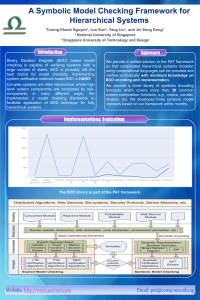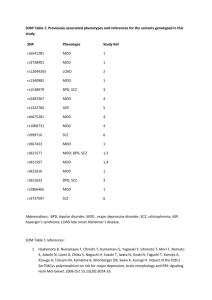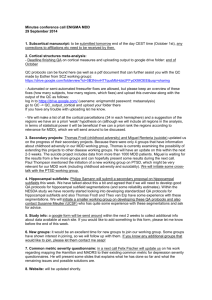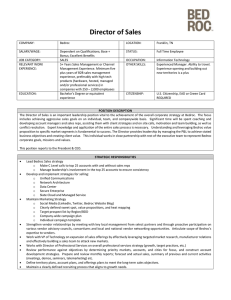Name (print): ID number: Science One number: University of British Columbia
advertisement
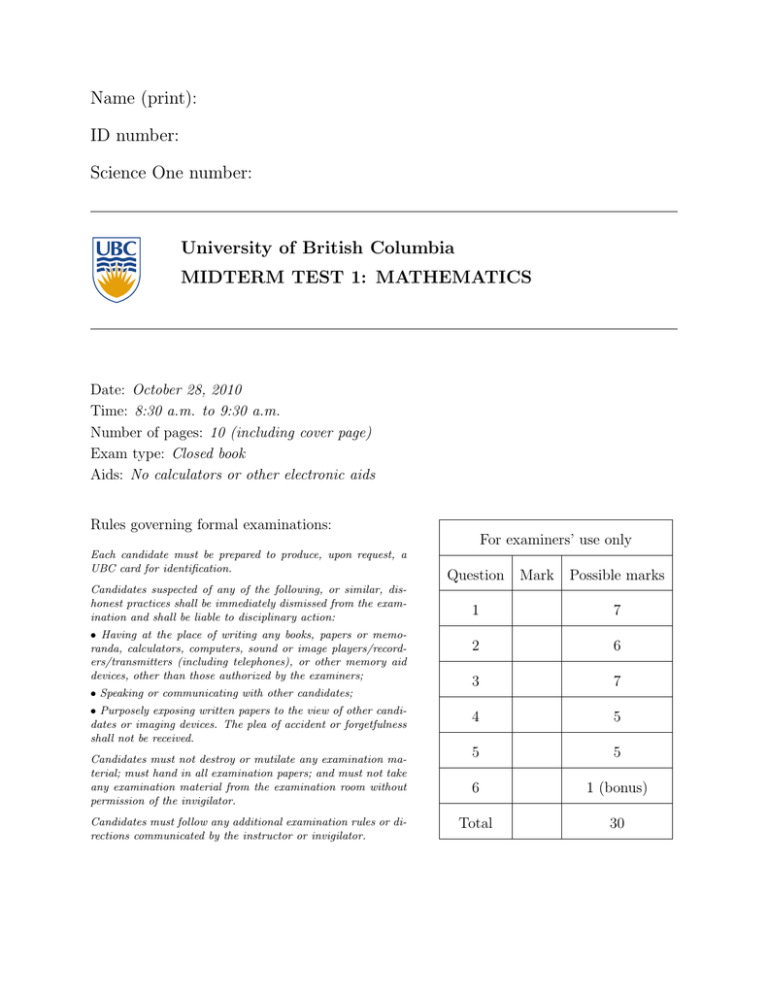
Name (print): ID number: Science One number: University of British Columbia MIDTERM TEST 1: MATHEMATICS Date: October 28, 2010 Time: 8:30 a.m. to 9:30 a.m. Number of pages: 10 (including cover page) Exam type: Closed book Aids: No calculators or other electronic aids Rules governing formal examinations: For examiners’ use only Each candidate must be prepared to produce, upon request, a UBC card for identification. Candidates suspected of any of the following, or similar, dishonest practices shall be immediately dismissed from the examination and shall be liable to disciplinary action: • Having at the place of writing any books, papers or memoranda, calculators, computers, sound or image players/recorders/transmitters (including telephones), or other memory aid devices, other than those authorized by the examiners; • Speaking or communicating with other candidates; • Purposely exposing written papers to the view of other candidates or imaging devices. The plea of accident or forgetfulness shall not be received. Candidates must not destroy or mutilate any examination material; must hand in all examination papers; and must not take any examination material from the examination room without permission of the invigilator. Candidates must follow any additional examination rules or directions communicated by the instructor or invigilator. Question Mark Possible marks 1 7 2 6 3 7 4 5 5 5 6 1 (bonus) Total 30 1. Consider the following propositions: W M B Wdd = “The woman is blue”. = “The man is blue”. = “The boy is blue”. = “The woman has alleles dd ”. WDd Mdd MDd Bdd = “The woman has alleles Dd ”. = “The man has alleles dd ”. = “The man has alleles Dd ”. = “The boy has alleles dd ”. 1. Consider the following axioms: ¬W, ¬M, B, Bdd ⇒ (Wdd ∨ WDd ) ∨ (Mdd ∨ MDd ). 1. (a) [2 marks] Provide the smallest possible truth table that shows that these axioms are consistent. 1. (b) [3 marks] Fill in the “Justification” and “Axioms” columns of the proof on the following page. In the Justification column, provide the Rule of Inference used and the rows to which the rule was applied. In the Axioms column, provide the list of axioms on which the theorem depends. 1. (c) [1 mark] What does the hypothetical axiom (5) mean, in biological terms? 1. (d) [1 mark] What is the conclusion, in biological terms? 2 Proposition Justification Axioms 1. ¬W Ax 1 2. ¬M Ax 2 3. B Ax 3 4. (Bdd ∨ BDd ) ⇒ ((Wdd ∨ WDd ) ∨ (Mdd ∨ MDd )) Ax 4 5. (B ⇔ (Bdd ∨ BDd )) ∧ ((W ⇔ (Wdd ∨ WDd )) ∧ (M ⇔ (Mdd ∨ MDd ))) HAx 5 6. B ⇔ (Bdd ∨ BDd ) P5 5 7. (W ⇔ (Wdd ∨ WDd )) ∧ (M ⇔ (Mdd ∨ MDd )) P5 5 8. W ⇔ (Wdd ∨ WDd ) P7 5 9. M ⇔ (Mdd ∨ MDd ) P7 5 10. (B ⇒ (Bdd ∨ BDd )) ∧ ((Bdd ∨ BDd ) ⇒ B) ME 6 5 11. B ⇒ (Bdd ∨ BDd ) P 10 5 12. (Bdd ∨ BDd ) 13. ((Wdd ∨ WDd ) ∨ (Mdd ∨ MDd )) 14. (W ⇒ (Wdd ∨ WDd )) ∧ ((Wdd ∨ WDd ) ⇒ W ) 15. (Wdd ∨ WDd ) ⇒ W 16. ¬(Wdd ∨ WDd ) 17. (Mdd ∨ MDd ) 18. (M ⇒ (Mdd ∨ MDd )) ∧ ((Mdd ∨ MDd ) ⇒ M ) P9 5 19. (Mdd ∨ MDd ) ⇒ M ) P 18 5 20. M 21. M ∧ ¬M 22. ¬((B ⇔ (Bdd ∨ BDd )) ∧ ((W ⇔ (Wdd ∨ WDd )) ∧ (M ⇔ (Mdd ∨ MDd )))) MP 4, 8 P5 5 5 MT 13, 16 MP 17, 19 3 2. (a) [2 marks] Explain, in terms of δ and , what the equation lim f (x) = L x→a means. 2. (b) [4 marks] Prove, using the definition you provided above, that 1 x + 3 = 5. lim x→4 2 4 3. (a) [3 marks] Prove that lim (x − 1) sin x→1 1 x−1 =0 using appropriate theorems. (You need not prove this in terms of δ and .) 3. (b) [4 marks] Let 1 for x < 1 (x − 1) sin x − 1 f (x) = g(x) for 1 ≤ x ≤ 2 . x e for x > 2 Find a function g(x) such that f (x) is continuous everywhere. You must justify your answer. 5 4. [5 marks] Two sprinters end a race in a tie. Prove that, at some point in the race, they were running at exactly the same speed. (Hint: consider the function f (t) − g(t) and its derivative, where f (t) and g(t) denote the positions of the sprinters relative to the starting line at time t.) 6 5. [5 marks] Where do the maxima of cos 1 x occur? Justify your answer using appropriate tests. 7 6. [1 bonus mark] Recall that, under the Continuum Hypothesis, the cardinality of the uncountable set of real numbers R is denoted ℵ1 . Describe a set with “larger” cardinality. You do not need to justify your answer. 8 This page may be used for rough work. It will not be marked. 9 Table 1: Rules of Inference. The notation A ` B means: from statement A we can infer statement B as a valid argument. The validity of all these can (and should) be verified using truth tables. Lifted partially from Wikipedia’s Propositional calculus page. Rule name Formalism Modus Ponens (MP) ((p ⇒ q) ∧ p) ` q Modus Tollens (MT) ((p ⇒ q) ∧ ¬q) ` ¬p Disjunctive Syllogism (DS) ((p ∨ q) ∧ ¬p) ` q Projection (P) (p ∧ q) ` p Conjunction (C) p, q ` (p ∧ q) Addition (A) p ` (p ∨ q) De Morgan’s Theorem (1) (DMT) ¬(p ∧ q) ` (¬p ∨ ¬q) De Morgan’s Theorem (2) (DMT) ¬(p ∨ q) ` (¬p ∧ ¬q) Distribution (1) (D) (p ∧ (q ∨ r)) ` ((p ∧ q) ∨ (p ∧ r)) Distribution (2) (D) (p ∨ (q ∧ r)) ` ((p ∨ q) ∧ (p ∨ r)) Double Negation (DN) p ` ¬¬p Double Negation (DN) ¬¬p ` p Transposition (T) (p ⇒ q) ` (¬q ⇒ ¬p) Material Implication (1) (MI) (p ⇒ q) ` (¬p ∨ q) Material Implication (2) (MI) (¬p ∨ q) ` (p ⇒ q) Material Equivalence (ME) (p ⇔ q) ` ((p ⇒ q) ∧ (q ⇒ p)) Rule of Deduction (RD) (A1 , A2 , A3 , · · · AN , p ` q) ` (A1 , A2 , A3 , · · · AN ` p ⇒ q) Rule of Contradiction (RC) (A1 , A2 , A3 , · · · AN , p ` q ∧ ¬q) ` (A1 , A2 , A3 , · · · AN ` ¬p) (For this last rule, A1 , A2 , A3 , · · · AN must be consistent.) The following rules can be “skipped steps”: Commutation (1) (p ∨ q) ` (q ∨ p) Commutation (2) (p ∧ q) ` (q ∧ p) Commutation (3) (p ⇔ q) ` (q ⇔ p) Association (1) (p ∨ (q ∨ r)) ` ((p ∨ q) ∨ r) Association (2) (p ∧ (q ∧ r)) ` ((p ∧ q) ∧ r) 10

